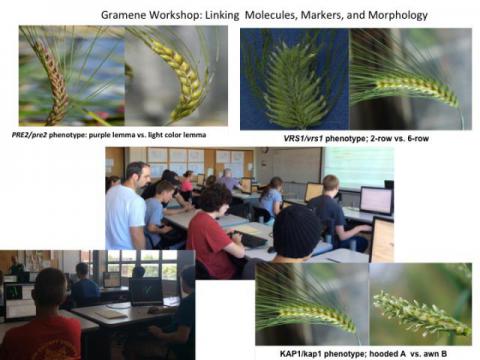Linking Molecules, Markers, and Morphology : a summer workshop for High School students
The Jaiswal laboratory at Oregon State University (OSU) organized DNA Biology & Bioinformatics workshop for High School students focused on ‘Linking Molecules, Markers and Morphology’ in summer 2014. The participants included 12 High School students from the local area.
The students were introduced to concepts of genetics and molecular biology and their applications in plant breeding. Dr. Sushma Naithani, Outreach Coordinator of Gramene project at OSU, introduced students to Mendel’s principles of inheritance, and supervised hands on laboratory exercise using Wolf-barley double haploid population (http://barleyworld.org). The students were asked to score dominant or recessive phenotypes corresponding to four known genes in 96 double haploid plants and then to find out if their data supports Mendel's law of independent assortment. The four gene chosen for this study were:
i) VRS1, phenotype; 2-row (OWB-D allele = A) vs. 6-row (OWB-R allele = B)
ii) ZEO, phenotype; Dwarf-head (OWB D allele) vs. tall head (OWB R allele)
iii) KAP, phenotype; hooded (OWB D allele) vs. awn (OWB R allele)
iv) PRE2, phenotype: purple lemma (OWB D allele) or light color lemma (R allele)
The students analyzed phenotypes in 96 F2 double-haploids and found that their results do not fit into Mendel’s principle of segregation and independent assortment. We discussed various scenarios in which the data could fail to support ‘principle of segregation and independent assortment’ and discussed location of these four genes on barley chromosomes.
The three genes VRS1, PRE2 and ZEO are located in the chromosome 2 of Barley and thus do not follow the Mendel’s law of independent segregation. Students were introduced to the concept of linkage and how often it breaks during meiosis due to recombination event. It was also discussed how using the data from F2 population can be used to map distances between two genes on the same chromosomes. The discussion was initiated about how Linkage is exploited by plant breeders for developing new plant varieties, when a breeder might want to "break" a linkage between a desirable gene and an undesirable one. How knowledge of the map distance between the desirable and the undesirable loci can help to estimate how many progeny plants should be analyzed to have a high probability of having at least one individual in which linkage has been broken.
The sequence of Vrs1 gene of barley, available from the NCBI, was used for various exercises using online tools including BLAST, Artemis, Pfam, Cn3D, etc. to annotate genes, gene products (proteins), assign function to proteins, compare to other well-known homologous proteins, and model protein 3D structures. Dr. Justin Elser, Justin Preece and Dr. Sam Fox introduced various bioinformatics tools for DNA/gene analysis to students. Dr. Pankaj Jaiswal, Associate Professor at Oregon State University led the instruction, planning and coordination of the course, and Cathy Law, Director, STEM academy at OSU coordinated student enrollment, and their transportation, housing, etc. The funds for the course were provided by the National Science Foundation (NSF) funded projects, The Plant Ontology (IOS:0822201) and Gramene: A Comparative Genomics Database (IOS: 1127112).

- Sushma_Naithani's blog
- Log in to post comments
